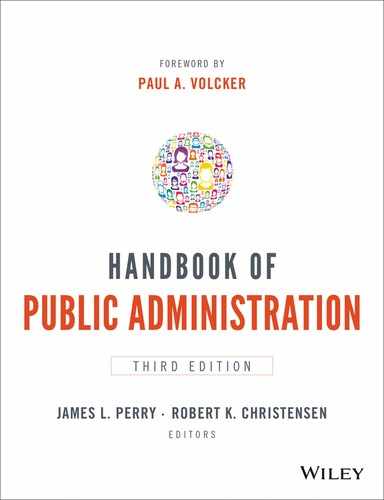Part 3
Implementing Policy Using Tools of Collective Action
Part 3 focuses on how the public administrator's relationships and decisions influence public policies and programs. Success in formulating and implementing policy requires that public administrators develop supportive relationships with key stakeholders in their environment, effectively manage intergovernmental and contractual relationships, and develop appropriate program designs and implementation strategies. Thus, the chapters in this part provide insights into processes and choices that are critical for managing public policies and the tools for delivering programs and services.
Regardless of how diverse or complex public networks are, most public administrators must pay special attention to legislatures. In chapter 9, Anne Khademian and Fatima Sharif spell out how public administrators manage the tension between accountability and flexibility in developing effective legislative and executive relationships. Given the breadth of legislative oversight in most jurisdictions, poor legislative—executive relationships can have profound consequences not only for government officials but everyone else who works with them in policy systems and networks. Thus, effective relations with legislatures is a priority for those with a stake in implementing tools of collective action.
A factor that proves critical for public administrators in building and maintaining their reputations with legislatures is how effectively they design and implement public policies and programs. In chapter 10, Michael Howlett, Ishani Mukherjee, and Jeremy Rayner articulate what we understand about deliberate efforts of governments to apply formal and practical knowledge to courses of action that are likely to succeed in attaining desired goals. The likelihood that a public program will be effective often depends on decisions by policy planners and legislators about the design of the policy. In recent years, we have developed better empirical evidence about what types of policies work and in what situations. This chapter reviews the findings of the policy design research to identify guidelines for designing effective policies.
Although many public programs like national defense and police and fire protection are delivered directly by governments, public administrators often rely on indirect tools such as grants and contracts. These tools modify the job of government but do not fundamentally change the need for effective public administrators. Sean Nicholson-Crotty addresses an indirect tool of long standing, grants-in-aid, in chapter 10. Grants, a time-tested instrument for public action, continue to evolve to meet changing political, economic, and social conditions. This chapter summarizes what we know about them as a tool of government and how recipients of grants-in-aid can manage the administrative burdens associated with them.
A second major indirect tool of collective action is contracting, which Zach Huitink, David Van Slyke, and Trevor Brown illuminate in chapter 12. Because so much of the public sector's work is now performed by third parties through contracts, managing contracts has become an important governmental activity. This chapter reviews what we know about how public administrators that can make contracting a winning proposition for citizens and public purposes.
Grants and contracts are indirect tools in which originating governments can strongly influence results through the quality of their management and monitoring. Other collective action tools may give governments less leverage because the production chain makes the relationship even more indirect. Coproduction is one such tool. Tony Bovaird and Elke Loeffler provide a guide to the history, design, and management of coproduction in chapter 13. They define coproduction as “public service professionals and citizens making better use of each other's assets, resources and contributions to achieve better outcomes or improved efficiency” (Bovaird & Loeffler, 2012, p. 1121). Their definition thus incorporates the jointness between public professionals and citizens that has long been associated with the concept and allows as well for diverse forms of sharing in coproduction relationships.
In the concluding chapter of part 3, Wolfgang Bielefeld tackles entrepreneurship, an indirect tool that is manifest in different ways across sectors. Entrepreneurs are individuals who tackle major public problems and offer ideas for large-scale change to solve them. Bielefeld notes that entrepreneurship for public good occurs in the public sector, nonprofit sector, for-profit sector, and multisector settings. This chapter explores the many forms entrepreneurship takes, provides examples of its applications, and examines factors that drive success and failure.
These chapters suggest that public administrators can facilitate successful public policy by developing appropriate relationships and designs. Making public policy is a continuous process, entailing analyzing alternative program designs, implementing legislative and top executive decisions, and evaluating outcomes.
